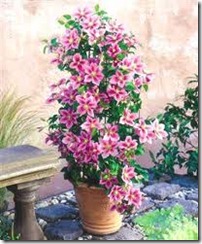Climbing vines add height, color and shade to a garden. Clematis (Clematis spp.), a flowering vine hardy in U.S. Department of Agriculture plant hardiness zones 5 through 9, grows 5 to 25 feet long, depending on the variety, and produces showy blooms in pale and bright colors. Although several methods of propagating the plant exist, the simplest and most inexpensive is by taking cuttings during the summer months and rooting these to establish new plants.
- Difficulty:
- Moderate
Instructions
things you’ll need:
- Knife
- Glass
- Water
- Sand
- Peat
- Peat pot
- Drill
- Flat
- Round bowl
- Rooting hormone
- Pencil
- Plastic bag
- Elastic band
- Large pot
- Potting mix
- Inspect a healthy, disease-free clematis vine. Select a 6-inch shoot from the current season’s growth. Make sure the shoot is still semi-soft or part-green.
- Cut through the shoot with a single stroke of a straight, sharp knife. Take several cuttings. Place each cutting in a glass of water out of direct sunlight.
- Fill a 4-inch peat pot to within 1/4 inch of the rim with 2 parts sand and 1 part peat. Make sure the pot has drainage holes in its base. Place it over a saucer or flat. Add water until it flows out through the holes.
- Fill a small bowl with rooting hormone. Remove flowers or buds from the cutting, along with all leaves from the lower 2 inches. Dip the bottom the cutting into the rooting hormone powder so that it is completely covered. Take it out and gently tap it to remove excess powder.
- Make a planting hole for the cutting with a pencil and place the powder-covered end into the hole.
- Cover the pot with a clear bag and secure it with an elastic band. Place the pot near a brightly lit window, away from direct sunlight.
- Inspect the cutting frequently for signs of roots. Keep the potting mix evenly moist. The clematis cutting will root in four to six weeks. Signs of rooting include new leaf growth, roots that grow out of the drainage holes, or resistance when you gently tug the cutting.


Deprecated: strpos(): Passing null to parameter #1 ($haystack) of type string is deprecated in /home/agriviek8Qv/agriviet.net/public_html/wp-includes/comment-template.php on line 2522